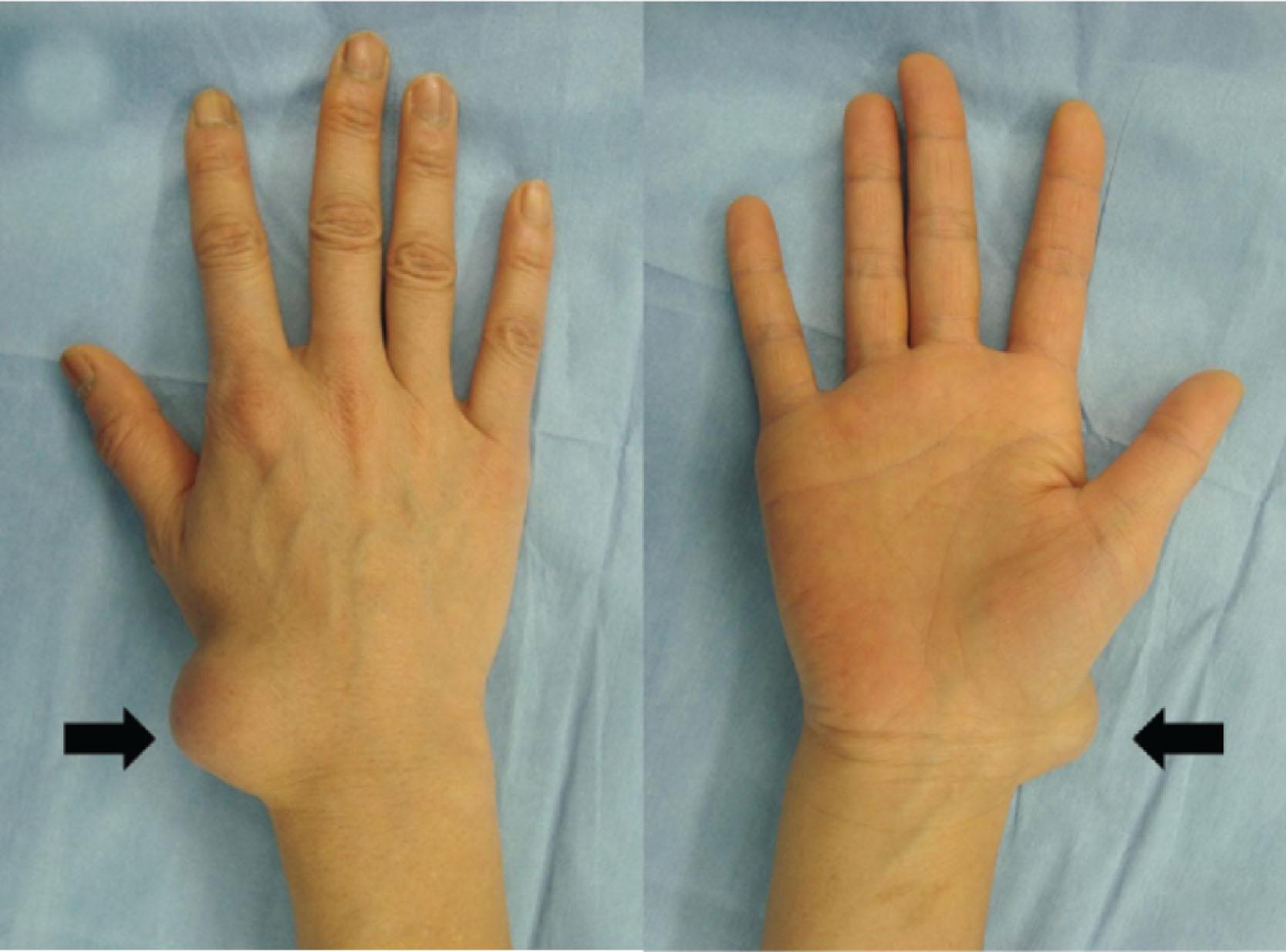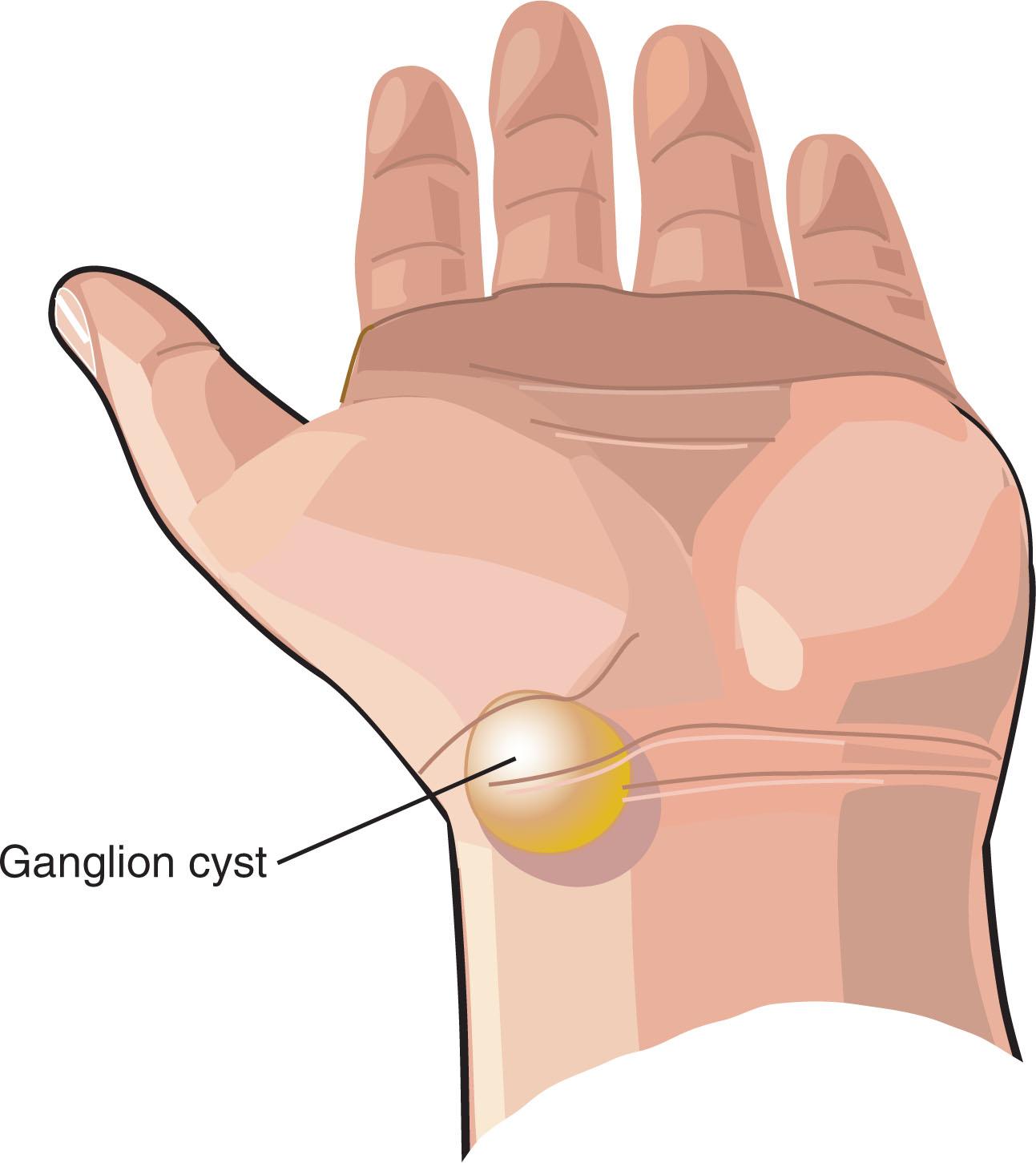Physical Address
304 North Cardinal St.
Dorchester Center, MA 02124
Learn the common causes of wrist pain.
Develop an understanding of the unique anatomy of the wrist joint.
Develop an understanding of the characteristics of ganglion cysts.
Develop an understanding of the causes of ganglion cysts.
Develop an understanding of the differential diagnosis of ganglion cysts.
Learn the clinical presentation of ganglion cysts.
Learn how to examine the wrist.
Learn how to use physical examination to identify ganglion cysts.
Develop an understanding of the treatment options for ganglion cysts.

Jessie Bumgartner is a 64-year-old homemaker with the chief complaint of “I’ve got a bump on my wrist and it won’t go away.” Jessie stated that over the past several months her right wrist started “swelling up like a balloon.” She went on to say, “This is so embarrassing! I always had pretty hands.” I asked Jessie if she ever had anything like this before, and she said, “Are you kidding? Look at this! Doctor, do you know what a manitou is? Because that is what this is beginning to look like.” I responded, “You mean the Canadian province Manitoba?” She laughed, then said, “No, Doctor, a manitou.” I replied, “Jessie, you got me there. Tell me what a manitou is.” She said, “Doctor, you need to up your game here. A manitou is a spiritual being that returns to this world and grows on a living being. It’s an old Native American legend, and that is just what this looks like.” I let that sink in for a minute, and then said, “So you think a spirit is growing in that lump on your wrist?” Jessie laughed again and said, “Well, unless you have a better idea, I am stuck with a manitou. But whatever it is, it’s certainly getting bigger, and it hurts when I move my wrist. This is really not the look I am going for now that I am back on the dating scene. My manitou is not going to help me on eHarmony!”
I asked Jessie what made her wrist pain worse, and she said that any movement of the wrist, especially flexion, caused pain. “Doctor, I can live with the pain, but the look is really not working for me. This is really embarrassing—nothing Botox or fillers are going to fix.” I asked her what made the pain better, and she said Advil seemed to help the pain but not the swelling, but the Advil was upsetting her stomach. She noted that the heating pad felt good, but she thought it made her wrist swell more. “I also tried using an Ace wrap, but I felt like it was cutting off my circulation.” I asked Jessie about any antecedent wrist trauma, and she said, “Not that I can remember.”
I asked Jessie to point with one finger to show me where it hurt the most. She pointed to one of the largest ganglion cysts I had ever seen. She really wasn’t kidding when she said the wrist had something growing on it. It literally was no exaggeration. “So this is what a manitou looks like?” I asked ( Fig. 8.1 ).

On physical examination, Jessie was afebrile. Her respirations were 16 and her pulse was 74 and regular. Her blood pressure was 126/76. Jessie’s head, eyes, ears, nose, throat (HEENT) exam was normal, as was her cardiopulmonary examination. Her thyroid was normal. Her abdominal examination revealed no abnormal mass or organomegaly. There was no costovertebral angle (CVA) tenderness. There was no peripheral edema. Her low back examination revealed some tenderness to deep palpation of the paraspinous musculature. Visual inspection of the right wrist revealed a huge dorsal ganglion cyst (see Fig. 8.1 ). The cyst transilluminated with a penlight, effectively ruling out a solid tumor. There was a positive ganglion cyst extreme flexion extension test with a marked increase in pain with extreme flexion of the wrist ( Fig. 8.2 ). Range of motion of the wrist joint, especially resisted extension and passive flexion of the wrist joint, caused Jessie to cry out in pain. The left wrist examination was normal, as was examination of her major joints. A careful neurologic examination of the upper and lower extremities revealed there was no evidence of peripheral or entrapment neuropathy, and the deep tendon reflexes were normal.

Gradual onset of a mass on the dorsum of her right wrist
Pain with flexion and extension of the wrist
Significant concern regarding the cosmetic impact of the wrist
Pain made worse with extreme flexion of the wrist
No other specific traumatic event to the area identified
No fever or chills
Patient is afebrile
Large mass on the dorsum of the right wrist
Wrist mass transilluminates
No evidence of infection
Pain on range of motion, especially extreme flexion of the affected right wrist
The extreme flexion/extension test for ganglion cyst of the wrist was positive on the right (see Fig. 8.2 )
Become a Clinical Tree membership for Full access and enjoy Unlimited articles
If you are a member. Log in here